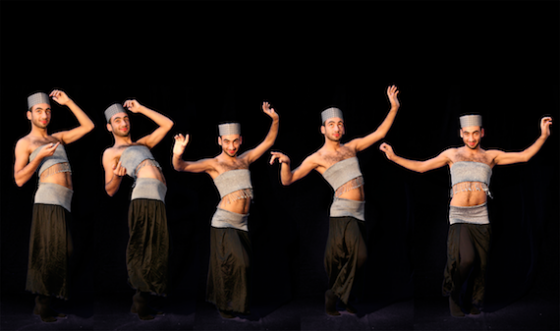Paris art exhibit tackles Islamic taboos in a show aimed at broadening Western views of Mid East culture.
Oooh la la…The Body Uncovered, at Paris’ Arab World Institute (AWI), presents two hundred controversial paintings, photographs, sculptures and videos that tackle variations of a provocative theme: the naked body. A mix of art forms created by over 70 Arab artists spotlight subtexts rarely exposed in Arab culture: sensuality, violence against women, and homosexuality.
Renaud Muselier, AWI chairman, says the exhibition strives to “challenge stereotypes usually associated with the Arab world that reduce it to the single image of religious fanaticism. It is intended instead to echo the reality of an Arab art scene that exists despite the conservative climate, dares to overcome taboos and manages to find a place in the global contemporary art scene.”
Given the spicy subject, the number of participants is remarkable. Their artwork is broadly themed and richly rendered. The modern and contemporary pieces bow to forerunners in the Arab art world dating back to the late 19th century. Turn-of-that-century painters from Lebanon, Syria and Egypt frequently studied in Europe where they experimented in nude painting and drawing that was forbidden back home. As with their literary compatriots in the Arab Renaissance, the artists were open to Western ideas which they melded with their Eastern heritage.
The exhibition, on view through July 15, was curated by Hoda Makram-Ebeid and Philippe Cardinal. “We hope to show the Middle Eastern public that there are Arabs who dare to explore this subject that has been hidden by a certain hypocrisy in the Arab world. And to show the Western public that there are artists who show, think, and act in ways other than according to the stereotypes of Arab society,” Makram-Ebeid told ARTINFO France.
Contemporary artists includes photographer Youssef Nabil with his Orientalist-inspired photograph “Natacha Sleeping”, and painter Ghada Amer, whose works depict female figures with their legs wildly akimbo.
Humor abounds, as in Mehdi-Georges Lahlou‘s photograph “Mouvement décomposé,” which shows the artist performing a belly dance in women’s clothing . Zoulikha Bouabdellah also riffs on bellydancing, with a video of the dance performed to the Marseillaise.
Co-curator Philippe Cardinal said “When there are social taboos, the role of artists is to unravel them at the seams: they are the first to rebel against censorship.”
But it’s not all about titillation. The body is also shown in a social and political context. Iraqi artist Adel Abidin‘s video “Ping-Pong” shows men playing ping-pong with a naked woman in place of a net. Her skin is marked with red circles left by missed shots, her body shudders each time she’s hit. The woman represents “the Iraqi people caught in the midst of war,” said Makram-Ebeid. It’s also a metaphor for the oppression of women.
 Homosexuality, forbidden in Arab countries, is represented in Lebanese-American George Awde’s photographs of young men in Beirut, shirtless, embracing. An his 2009 video “Comradeship”, Egyptian artist Mahmoud Khaled features a bodybuilder flexing his muscles, clad in a form-fitting bathing suit.
Homosexuality, forbidden in Arab countries, is represented in Lebanese-American George Awde’s photographs of young men in Beirut, shirtless, embracing. An his 2009 video “Comradeship”, Egyptian artist Mahmoud Khaled features a bodybuilder flexing his muscles, clad in a form-fitting bathing suit.
There’s also a man rubbing oil onto another bodybuilder’s muscles. The accompanying text says in both Arabic and English: “I have taken courage to challenge myself and you have taken time to allow this to affect you. The payoff is well worth it.”
Tarik Essalhi‘s sculpture “Abu Ghraib” depicts a prisoner as a modern day Saint Sebastian. Palestinian artist Hani Zurob opts for a less direct interpretation of captivity in a blue painted portrait representing his own incarceration in an Israeli prison.
Zena el-Khalil‘s mixed media “Beefsteak” shows three bearded men, one of them holding a machine gun, all wearing girls’ dresses. It refers to “all the television images she saw as a child. Images of war, Michael Jackson videos, and Barbie dolls; kitsch remained and got mixed together in her mind,” according to Makram-Ebeid. “The world is made of contradictions; everything happens so fast — in hybrid fashion, she shows war and the levity of childhood in a kind of blur.”
Huguette Caland, a Lebanese painter now resident in California, looms large as the show’s powerhouse. The daughter of the first president of Lebanon, she splashed onto the 1960′ s art scene with her oversized monochromatic body part paintings. “Now she’s 83, and she was a pioneer at the beginning of women’s liberation,” Makram-Ebeid said. “She dared to work on the body, nudity, and women’s sexuality.”
While most of these artists were born in Arab countries, they now live and work mainly in Europe and the United States. It’s unlikely the exhibition would ever travel to Arab countries, and improbable that such art would be openly produced in Islamic states. To date, there has been no critical backlash.
For those not able to step into the Paris gallery, a virtual visit to the artists’ websites will allow a fuller view of these remarkable and provocative works.
Images of a still from Adel Abidin’s video “Ping-Pong; Youssef Nabil’s “Natacha Sleeping”; Mehdi-Georges Lahlou’s photograph “Mouvement décomposé; and George Awde’s “Quiet Crossing” all courtesy of Arab World Institute




Hmm…not quite sure why we’re swapping comments like so many ping-pong balls.
Piece is about an art show, couldn’t say if any of the players are angels or “crooks”.
Good to hear Abidin’s short subject is getting wider play: it’s innovative and provocative, but as noted previously, it’s digital media and able to avoid the challenges inherent in 2-D and 3-D artwork.
Let’s agree to disagree?
If I read how the other works travelled freely through Islamic countries, I (and AWI curators) will see we are “wrong”.
“I’ll stand by what I reported. It remains improbable that those non-digi artworks would travel to Islamic communities, largely due to limited subject appeal, and also due to prohibitive insurance requirements to safeguard the works.”
They were; the Adel Abidin video was exhibited here for example; http://www.egyptindependent.com/news/yet-another-form-resistance
What else can prove you wrong? Of course, you can find Middle-Eastern government workers, media or clerics who will tell you that there is no way you will see this in the region, but then do they represent society or religion?
Let’s try to make judgements by what’s happening on the ground, not by what the crooks tell us.
And that’s what the exhibition was about;
Renaud Muselier, AWI chairman, says the exhibition strives to “challenge stereotypes usually associated with the Arab world that reduce it to the single image of religious fanaticism. It is intended instead to echo the reality of an Arab art scene that exists despite the conservative climate, dares to overcome taboos and manages to find a place in the global contemporary art scene.
Thanks for the comment, Does – but I’ll stand by what I reported. It remains improbable that those non-digi artworks would travel to Islamic communities, largely due to limited subject appeal, and also due to prohibitive insurance requirements to safeguard the works.
Regardless of where the video was shown, it’s digital media. It can be accessed easily most anywhere. That practically all of the participating artists are not based in the Middle East further underscores the point of topical prohibition.
Do let us know if you see “The Body Uncovered” on display in the region – it would be an amazing sea-change in cultural mores.
It wasn’t via the internet, the video was exhibited in public space. That’s why I reacted, because it proves that your remark isn’t very just;
“It’s unlikely the exhibition would ever travel to Arab countries, and improbable that such art would be openly produced in Islamic states.”
Great that the piece reached Egyptian audiences. That’s the beauty of the internet – digital media can make it’s way through unless purposefully restricted.
As example, there’s a clip of the piece (by Adel Abidin) on Vimeo right now.
http://vimeo.com/10580875
Traditional 2-D media remain less accessible (a still of an actual artwork will never do it justice).
“While most of these artists were born in Arab countries, they now live and work mainly in Europe and the United States. It’s unlikely the exhibition would ever travel to Arab countries, and improbable that such art would be openly produced in Islamic states. To date, there has been no critical backlash.”
Ahum, I recognise the ping pong table picture (do you know who made the video, it’s very nice) in a Cairene cultural centre a couple of months ago, so you’d better cancel that remark.